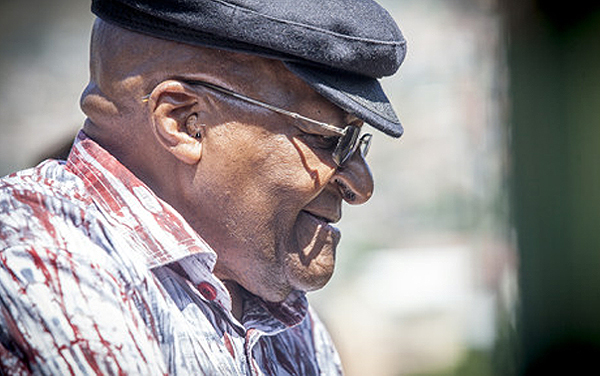 There’s an intersection in the middle of Nairobi city which we used to call the Square of Churches years ago. There’s only one church there, the city’s main Catholic Cathedral, Holy Family Minor Basilica, and it’s a roundabout so I have no idea how the moniker developed.
There’s an intersection in the middle of Nairobi city which we used to call the Square of Churches years ago. There’s only one church there, the city’s main Catholic Cathedral, Holy Family Minor Basilica, and it’s a roundabout so I have no idea how the moniker developed.
Kitty-corner from the Basilica is Jomo Kenyatta’s Mausoleum. Between the two on the north end is the Intercontinental Hotel, and kitty-corner from that, City Park. If the new highway didn’t obscure my nostalgic memories I’d suggest that the name of the place be changed to the Desmond Tutu Plaza.
Daniel arap Moi was Kenya’s dictator for 24 years from 1978 to 2002. His regime was mostly benign, on partial life-support after the end of the Cold War reduced his clout with the West. But the frustration – particularly among the young and Kenya’s religious leaders – grew violent towards the end of his regime.
The demonstrations usually climaxed at the Square of Churches.
One reason the organizers chose the Square as the place to make their point was that they could take sanctuary in the Basilica … until they couldn’t, when the police ran right into the sanctuary after them. At that point any dissent in the country was totally crushed. Most journalists had already been jailed, but it was then that the Moi regime started to jail the religious leaders as well.
In the panoply of modern African nations, Kenya and Tanzania are quite religious. This is thanks mostly to the old corrupt King of Belgium who created then hosted a conference to divide Africa not just geopolitically but religiously. He knew that if he kept the French and British separated by the Congo jungle that he’d create an opportunity for himself, which he later exploited horrendously.
So Leopold gave East Africa to the British religious societies, many of which had already a significant toehold thanks to early British missionaries in South Africa.
So Moi’s jailing of the religious leaders was the straw that broke the camel’s back… but it was surprisingly delayed.
[The world really didn’t seem to care. EWT’s safaris were flourishing undeterred. Western and eastern ambassadors held riotous cocktail parties in the north rooms of the Intercontinental. Sometimes I wonder in retrospect if the clasp on dissent was so great that we just didn’t know about it at the time. Then I remember turning on my Grundig and listening to BBC-Africa. No, we heard about it. We just chose not to listen.]
Moi did anything for good press. His principle ploy was to gather all the unjailed journalists in the same building where he could “focus his attentions”. He did this by creating a “journalist tower” on Kenyatta Avenue where news agencies were offered ridiculously cheap rents. It became a legendary propaganda machine as dozens and dozens of journalists from all over the world began to report on all the good things Kenya was doing.
So when Desmond Tutu announced that he wanted to hold an important Anglican Conference in Nairobi in the midst of all this oppression and terror, Moi’s smile grew to the size that was immortalized by the cartoonist, Zapiro, for the rest of this miserable reign.
And guess what? The rest of the world – including me – started to scratch their heads.
Tutu knew the curiosity turned criticism would be directed at him. Anglican conferences around the world scolded him for agreeing to hold a conference of morality in Nairobi. Even I wondered if Tutu had been corrupted. There was even talk that he should be defrocked!
And, of course, the global press was energized beyond belief. You can’t imagine the numbers of cameras clicking and cars bumping and dogtags swinging that congested the Square of Churches that morning.
I watched it on KBC. I was in Nairobi but knew that there was no way I could get near the Square of Churches and see anything. So I sat in my room at the Norfolk and switched on the TV. I think it was on every local channel.
I remember that Tutu, wearing his black garments looked like he was drowning in microphones. He’s a short, little man, and the podium had obviously not been arranged correctly for him.
Reporters were shouting questions, while truly big men of questionable origin were stiff-arming people away from the podium.
Finally, the pandemonium subsided. Tutu pulled a mike closer to him and in that iconic almost squeaking grandfather’s voice said a prayer that gave him some silence then to continue.
He looked to his left and found the big gavel. Expressionless, he hit the base several times and declared the official opening of the African Anglican Conference. He spoke for a very short time, calling on Africans to be proud of who they were, warning them against despondency over years of misrule:
“Do not overdo self-tribulation,” he cautioned, adding that Africa was waiting to rise. He urged all Africans “to participate in the African renaissance”.
He then looked into the sea of humanity and TV cameras and raised the gavel, again. Pounding the based with unusual fervor he nearly shouted, “And I now end this conference.”
The absolute silence prompted him to explain:
“How on earth can we hold a religious conference in a country where all the religious leaders are in jail?”
And he walked away into another chapter of his remarkable history.